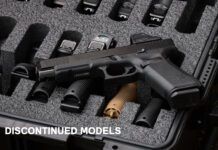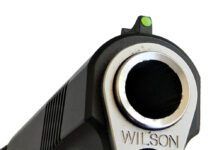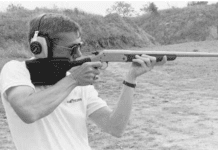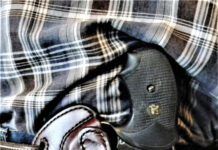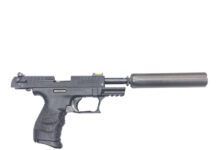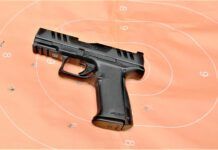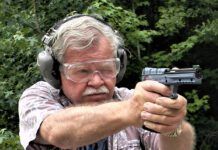Acquiring a good semiautomatic .22 LR pistol is probably the best way to learn how to shoot a handgun. Some of us went that way (see sidebar) and highly recommend the technique. But not just any gun will do. It has to have some weight, excellent sights, reasonable to excellent accuracy, and a decent trigger. Why weight? There are some nice but very light .22s out there, and the new shooter wont be able to hold them as steadily as a gun with a bit more weight, and may become discouraged.
So for this test of three .22 LR auto pistols, we selected three full-size examples. They were the newest version of Rugers Standard, now called the Mark III, with 6-inch barrel ($342), the Beretta U22 Neos with 4.5-inch tube ($250), and the Browning Buck Mark in its Standard URX version with 4-inch barrel ($380). All had ten-round magazines, good sights and decent triggers, and all were hand-filling, good-size guns. Two had adjustable sights. Two came with two magazines. In light of some extremely cold Idaho weather we chose to test with three types of ammunition only. It was Remington Yellow Jacket truncated-cone HP, CCI Mini Mag HP, and Federal Premium Gold Medal target ammunition. How did the guns stack up? Lets take a look.
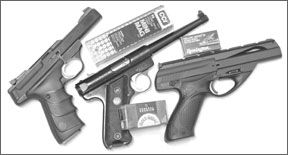
Ruger MKIII6 Standard .22LR, $342
There are several versions of the Ruger MKIII, but we chose one of the plainest, with the 6-inch barrel. This blued Ruger was exceptionally well balanced, something we all noticed right away. We all loved the feel of the grips, too. The grip angle seemed just right for most of us, and the checkered plastic panels were mighty comfortable as well as functional. Weve handled the 4-inch version of the Ruger Standard in the recent past and it didnt balance nearly as well for us. The Ruger Standard is the gun that put Sturm, Ruger & Co. on the map. Introduced in 1949 and selling for $37.50 for many long years, it provided the background and basic building blocks for todays huge Ruger operation. Were not sure how many Ruger Standards have sold, but the numbers passed the million mark back in 1979. There have been a few changes to the gun over the years, and most changes may be seen as improvements. We found a few items of contention, however. First, the good stuff.
The finish was outstanding. The metal polish and semi-matte bluing quality were about as good as it gets in todays market. The sheet-metal frame, tubular-steel action and nicely tapered barrel all had excellent metal work with no machining marks. The dovetailed rear and bold post front sights were well matched, easily seen, and excellent for their job. The front blade can be replaced easily if need be. The rear was adjustable for windage by drifting. The takedown system for cleaning was as mystical as ever, a distinct Ruger touch that has at first stumped and then-once understood-pleased shooters for many decades now. The checkered grips featured a red, not black, Ruger monogram and excellent tactile feel for positive and pleasant control of the gun. All the new guns controls but the safety were as easily operated by lefties as by the right-handers.
Recent additions and/or changes include a button magazine release, not the old lever in the heel of the grip. Then theres a slide lock, and a hidden, internal security lock. On the left side of the main body in front of the embossed message is the new chambered-round indicator, essentially a slot that permits dust and dirt to enter the gun, and also tells the presumably careless shooter that a round is in fact in the chamber. We submit that if you dont know theres a round in the chamber you have no business handling this or any other firearm. (Rule one: All guns are always loaded, especially the one you just personally unloaded.)
We found another item thats been changed since the very first Rugers were built, and that is the bolt ears. In early versions these stuck out to the sides and were very easy to grasp and operate. Todays version has narrower ears, with cuts in the side of the main receiver tube to permit the fingers to grasp these shorter ears. We found these to be harder to grasp and operate than the early wider-eared version, and also the new system pinched the dickens out of our fingers more than once, something that never happened with the original design. Another change since the early days is todays Ruger MKIII will not fire with the magazine removed. Some shooters dont like this feature, because it can create a false sense of “safety” that doesnt translate to other, generally more serious, firearms like 1911s. Its a good idea for all ones guns to have exactly the same features, to help the shooter avoid handling mistakes. The gun came with two ten-round magazines. We loved the magazine release. We also loved the crisp, clean trigger, which broke at 3.5 pounds, best of this test. The feel of the grip and the fine balance of the gun weve already mentioned, as well as the clean sight picture.
We were eager to take the gun to the range. There we found it to be one of the finest handguns weve ever fired. The Ruger performed way better than it looked, and it looked pretty good, we thought. If you cant make a group smaller than an inch at 15 yards, youre just not trying.
Beretta U22 Neos .22LR, $250
If theres a homelier gun this side of Hi-Point, we dont know what it might be. The U.S.-made Neos had a sweeping cut on the base of its top hamper, or sight mount, or whatever they call it, that looked like the lip of a sneering shark. It looked like someone slipped badly while polishing the bottom of the metal, and they just went ahead and stuck the gun together with the swipe of metal missing. But were being nasty, and we do understand that many shooters will like the looks of the Neos. To our eyes the longer-barreled stainless (Inox) version was actually quite graceful looking, so we offer the above criticism very tongue in cheek.
Workmanship on the Neos seemed to be quite excellent everywhere we looked, and we thought it was a very interesting design. The top metal was aluminum, with an internal steel backbone, and it formed a handy mount for scope use. Another advantage to this setup is that the iron sights always remain in the same position relative to the barrel, so the gun should have been able to generate decent accuracy. The sights were a fully adjustable white-outlined rear with a black vertical front blade. The sights elevation adjustment screw was big enough, but the windage screw slot was mighty small, with a short and narrow slot. The sight picture was good, but some wanted more room on the side of the front blade. The front blade was removable by means of an Allen screw in the right side of the top metal.
The grip had way too much angle for most of us. We could not comfortably get our hand all the way up into the long-overhanging grip. Some individuals might prefer this, depending on the shape of ones hand. For us, the overhang interfered with the top of our hand when we tried to crowd the grip fully upward. Some of our test crews hands fit better than others, but it seemed that a slight reduction in that angle would help everyone. Next on our list of complaints was the ambidextrous safety. This was difficult to put on with only the controlling hand, and just as hard to take off. With the safety levers in the “On” position, the twin knobs jabbed the thumb and index finger when you grasped the gun. The magazine release worked well for right-handed shooters. It was under the extended right index finger. We liked this a lot. It was easy to use, and worked well. Left-handed shooters might not like it because it was out of reach for them, and the system is not reversible. The final control on the gun was the slide stop, which again we liked. For north-paws it was properly located. For southpaws, it was inaccessible to the controlling hand.
One item remained, which we called the mystery button. Before we looked in the manual we figured it was the takedown lever. We guessed that if you pressed this odd button, located far forward on the right side of the frame, it would then permit you to spin the little wheel next to it, which would then release the barrel from the frame. We were almost right. Press and hold the button with the slide locked back, and then you could indeed spin that wheel and take the barrel and top metal off the frame for cleaning from the breech. With the barrel off, grasp the slide, press the slide lock, and then remove the slide off toward the front. This was a nice system, we thought, easier to use than those of the other two test pistols. In short order and with no tools you had good access to the guts of the gun.
The barrel and slide were steel. The thick, contoured top metal that held the sights and provided the handy scope mount was aluminum, but with a steel insert. The grip frame was molded plastic with several steel parts inserted here and there to run the trigger mechanism, and to hold and retain the steel striker with its spring. The pistols grip surfaces had raised dots that worked like checkering. We liked the guns design features, but somewhat disliked the overall package. We would have liked to see a simpler, less spacey (as in outer space, or ray-gun) configuration to the main grip combined with making the top metal a lot less bulky, or leaving the top metal entirely off the gun and then putting perhaps less accurate but more friendly sights directly onto the slide, or onto the barrel itself. This would give a smaller, lighter, less top-heavy pistol that actually might get carried once in a while. But that is not what we had.
There was a second Neos on our bench, with a longer barrel and two-tone “Inox” (stainless) finish that we thought was better looking than our test gun. The Inox version costs $100 more, at $350. This longer-barreled gun had the same overall design, was heavier, and had a poorer trigger. Accordingly, we saw no reason to fire it. One the range, we found the Neos magazine was the easiest to load of all three guns. Two ten-round mags came with it. The trigger was perfectly acceptable, though the striker fall was maybe too heavy. We found we could live with the grip angle, though the excess top-heavy feel made us want to lay the gun over on its side and shoot it from the horizontal position, like the
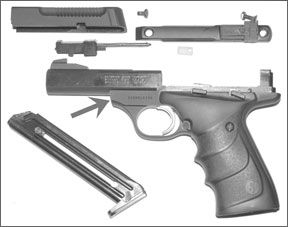
bad guys on TV. The Neos functioned like a trouper. No problems, no misfires, all rounds fed, fired and ejected perfectly. Then we looked at our groups and got the bad news.
All our groups were lousy, with all three types of ammo tried. The best group was just over an inch, but most were over 3 inches, with some closer to 5 inches. Try as we might, we couldnt get the gun to shoot anywhere near as well as the other two. On a cold, 5-degree day we shot half-inch groups with the Ruger, 1-inch groups with the Browning, but 5-inch groups with the Neos with match ammunition. That didnt give confidence. The Neos ought to have shot well. It had a barrel locked to its sights. Its only moving parts were the slide, the trigger, and the striker. We disassembled the gun, looked inside the barrel, and found the problem. The barrel was heavily leaded right in front of the chamber.
We thoroughly cleaned out the lead, no easy task. With the barrel as clean as we could get it we shot ten rounds of Federal match ammunition. They went into 2.6 inches, a distinct improvement but still not up to the other guns. We fired ten more and got a 4.1-inch group. We fired the longer-barreled stainless version, ten shots of the same fine ammo, and they went into 1.5 inches. We examined both barrels, and found no significant lead buildup in either gun. We then fired two more groups with the short Neos, using each type of test ammo. The groups with Yellow Jacket and Federal Match were as bad as ever, but we got groups of 2.0 and 2.5 with CCI Mini-Mag ammo, slight improvements. On again inspecting the barrel there were definitely traces of lead, though not much. We saw an area right in front of the chamber that seemed to be wavy or irregular, and it might have caused leading and attendant inaccuracy. The Neoss best performance was so far behind the other two test guns as to make the thought of scoping this gun for serious purposes somewhat ludicrous.
Browning Buck Mark Micro
Standard URX .22LR, $380
Our first impression of this version of the Buck Mark was that it looked well made, but seemed to have over-large grips. On closer examination, we decided that yes, it was very well made, and the grips are indeed on the stout side. Smaller hands would not be happy here. There are, however, two dozen variants of the Buck Mark shown on the company website (www.browning.com), ranging in price from $315 for the “Camper” up to $655 for the NRA Hi-
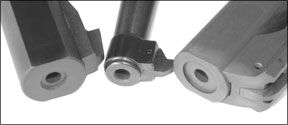
Grade with two barrels. Some of the versions have smaller grips. One version, the “Challenge,” specifically has smaller grips, plus a lighter barrel and significantly lower overall weight, nearly half a pound less than our versions nominal two pounds. We noticed the rather attractive pattern of the rubber grip material on our test gun looked like it was borrowed from a rhinoceros. By contrast, if you squint at the grips on the Neos, they look kinda like snake skin. Rugers checkered grips, need we add, look exactly like pistol grips.
We immediately disliked one aspect of the Buck Mark. The safety dug into the side of our thumb when we put the thumb where we wanted. Of course not everyone will have that problem. We loved the overall feel, the good looks, the fine workmanship, the rich blued finish, and the sights of the Browning. We even liked the look of the gold trigger. If you have medium-to-large hands youll do okay with the grips, which are indeed very comfortable, even for lefties, and they have an excellent grip angle. Incidentally, Browning suggests you not remove the grips when you clean the gun. To take it down for cleaning you must use an Allen wrench, and one is provided. You basically unbolt the barrel from the frame, two bolts, and that lets you get at the innards. Without a tool, field disassembly wont be possible. The Ruger also required a tool (paper clip) to get at its guts, though a knife or screwdriver could be used. Score one for the Neos, which requires only deft fingers. But one doesnt really need to strip a .22 after every shooting session, we suspect. Suffice to say that all three guns can be cleaned from the breech.
The Buck Mark would not fire with the ten-shot magazine removed. Neither would the Ruger. The Neos warned you with a note on the barrel that it indeed would shoot with the mag out. Browning provided only one magazine with the gun.
All the Buck Mark variants have adjustable sights that give an excellent sight picture, and these are attached to the gun in a manner that keeps them aligned with the barrel. The slide moves beneath the sight extension, which, by the way, is about the size of what wed like to see on top of the Neos. This Buck Marks barrel was milled on its sides, and the flat portion was given a fine polish and glossy blue, with an overall tasteful look. The remainder of the gun was a uniform and rich matte black. The barrel, slide, and sights were steel. The sight extension and frame were milled aluminum. The trigger pull was as clean as that on the Ruger, though a full pound heavier at 4.6 pounds.
0308-BROWNING-BUCK-MARK-MICRO.pdf


